| Part of a series on |
| Dedham, Massachusetts |
|---|
 |
| History |
| People |
| Places |
| Organizations |
| Businesses |
| Education |
Charles Mills (1856–1956) was an American artist.
| Part of a series on |
| Dedham, Massachusetts |
|---|
 |
| History |
| People |
| Places |
| Organizations |
| Businesses |
| Education |
Charles Mills (1856–1956) was an American artist.
Charles Mills was born in 1856 in Pittsburgh, Pennsylvania. [1] He attended Allegheny College for one year before moving to Europe at the age of 22. [1] There he studied under Frank Duveneck. [1] His most famous works include a series of murals at the Benjamin Franklin Institute of Technology, the Suter Window at Trinity Church, and the stained glass windows at Memorial Hall at Harvard University. [1]
He moved to Dedham, Massachusetts, in 1888.
Murals at the Benjamin Franklin Institute of Technology

Benjamin Franklin was an American polymath and one of the Founding Fathers of the United States. Franklin was a leading writer, printer, political philosopher, politician, Freemason, postmaster, scientist, inventor, humorist, civic activist, statesman, and diplomat. As a scientist, he was a major figure in the American Enlightenment and the history of physics for his discoveries and theories regarding electricity. As an inventor, he is known for the lightning rod, bifocals, and the Franklin stove, among other inventions. He founded many civic organizations, including the Library Company, Philadelphia's first fire department and the University of Pennsylvania.
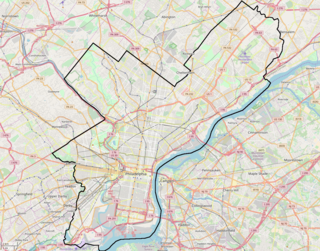
The Franklin Institute is a science museum and the center of science education and research in Philadelphia, Pennsylvania. It is named after the American scientist and statesman, Benjamin Franklin, and houses the Benjamin Franklin National Memorial. Founded in 1824, the Franklin Institute is one of the oldest centers of science education and development in the United States.
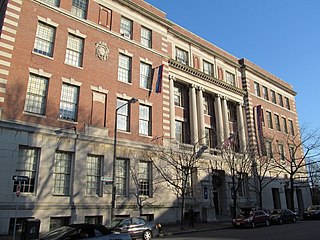
The Benjamin Franklin Institute of Technology (BFIT) is a private college of engineering and industrial technologies in Boston, Massachusetts. It was established in 1908 with funds bequeathed in Benjamin Franklin's will.

Robert Dennard is an American electrical engineer and inventor.

Christ Church Burial Ground in Philadelphia is an important early-American cemetery. It is the final resting place of Benjamin Franklin and his wife, Deborah. Four other signers of the Declaration of Independence are buried here, Benjamin Rush, Francis Hopkinson, Joseph Hewes and George Ross. Two more signers are buried at Christ Church just a few blocks away.

The Cathedral Basilica of Saints Peter and Paul, head church of the Roman Catholic Archdiocese of Philadelphia, is located at 18th Street and the Benjamin Franklin Parkway, on the east side of Logan Square in Philadelphia. It was built between 1846 and 1864, and was designed by Napoleon LeBrun, from original plans by the Reverend Mariano Muller and the Reverend John B. Tornatore, with the dome and Palladian facade, designed by John Notman, added after 1850. The interior was largely decorated by Constantino Brumidi.

Mother Brook is a stream that flows from the Charles River in Dedham, Massachusetts, to the Neponset River in the Hyde Park section of Boston, Massachusetts. Mother Brook was also known variously as East Brook and Mill Creek in earlier times. Digging the brook made Boston and some surrounding communities an island, accessible only by crossing over water, making Mother Brook "Massachusetts' Panama Canal."
Benjamin Franklin Hallett was a Massachusetts lawyer and Democratic Party activist, most notable as the first chairman of the Democratic National Committee.
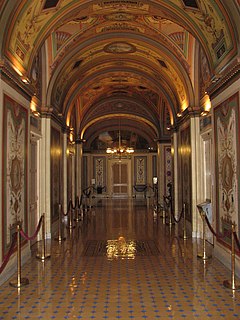
The Brumidi Corridors are the vaulted, ornately decorated corridors on the first floor of the Senate wing in the United States Capitol.
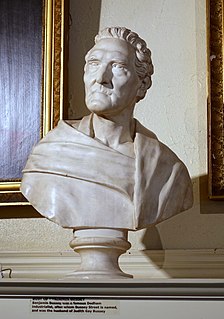
Benjamin Bussey (1757—1842) was a prosperous merchant, farmer, horticulturalist and patriot in Boston, Massachusetts, United States, who made significant contributions to the creation of the Arnold Arboretum. He was said to be "a man of excellent business capacity."

James Merrill Cook was an American businessman, banker and politician.

Charles Andrews was an American Lawyer and politician. He was Chief Judge of the New York Court of Appeals from 1881 to 1882 and from 1892 to 1897.

Coleman Sellers II was a prominent American engineer, chief engineer of William Sellers & Co., professor of mechanics at the Franklin Institute, professor of engineering practice at Stevens Institute of Technology and inventor. He obtained more than thirty letters-patent for inventions of his own, and served as president of the American Society of Mechanical Engineers from 1886 to 1887.
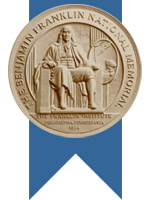
The Franklin Institute Awards is a science and engineering award presented since 1824 by the Franklin Institute, of Philadelphia, Pennsylvania, US. The Franklin Institute Awards comprises the Benjamin Franklin Medals in seven areas of science and engineering, the Bower Awards and Prize for Achievement in Science, and the Bower Award for Business Leadership.
Charles Thomas Main was an American mechanical engineer and business executive, who worked for New England textile mills, and also in the then new field of hydroelectricity. He is known as founder of Charles T. Main, Inc., and as president of the American Society of Mechanical Engineers in the year 1918-19.
Eugene John "Gene" Mele is a professor of physics at the University of Pennsylvania, where he researches quantum electric phenomena in condensed matter.

John Dwight was one of the first settlers of Dedham, Massachusetts and progenitor of the Dwight family.

Nathan Aldis was an early settler of Dedham, Massachusetts who served on that town's Board of Selectmen in 1641, 1642, and 1644. He served in a variety of other positions in the town and served as a deacon at First Church and Parish in Dedham. He signed the Dedham Covenant.